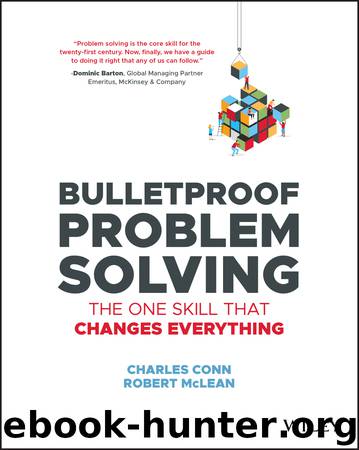Bulletproof Problem Solving by Charles Conn & Robert McLean

Author:Charles Conn & Robert McLean
Language: eng
Format: mobi, epub
Publisher: Wiley
Published: 2019-09-20T16:00:00+00:00
Firepower Availability
It used to be that larger problems involved specialist‐managed, time‐intensive, and costly analytic processes. With the rapid rise in available computing power and the decline in data storage costs, more of these tools are now accessible. Software packages that allow you to run sophisticated analyses with only a few command lines are becoming more common, and have become substantially more straightforward for the everyday user. For example, regression analysis is available in Excel by loading the Analysis ToolPak, and Monte Carlo simulation and other tools are available from the R‐Project, a free analytic software resource.
Given greater accessibility, we are seeing increased use of sophisticated modeling tools, such as machine learning, earlier in the problem solving process in businesses, consulting firms, and government institutions. Sometimes this is warranted, but often the use of high‐powered tools seems to be premature or misplaced. As we saw in Chapter 5 , before embarking on complex analyses, we believe you are better off refining your thinking about the problem structure and the hypotheses you're testing by doing some initial order‐of‐magnitude analysis. Why? First‐cut data analysis often points to direction of causality and size of impact, which are critical to evaluating the results of complex models later. Showing model correlations in the absence of clear explanation doesn't prove anything. And knowing that one configuration or algorithm explains slightly more variance in a multivariable model often brings you no closer to understanding root causes. Data‐fishing expeditions or unfocused analysis that “boil the ocean” are likely to result in inefficient problem solving.
Professor Stephen Roberts, a machine‐learning expert at Oxford, emphasizes the need to rigorously frame a question or hypothesis before embarking on complex analysis. He advises students not to commence machine‐learning analysis until such time as they have developed a clear idea of the structure of the model and testable hypotheses, the essence of the scientific method. 1
In this chapter, we explain where and how to apply advanced analytical approaches, as well as some of their limitations. Even if you don't personally employ the analytic big guns, you are likely to be presented with analysis that comes from these approaches.
Download
Bulletproof Problem Solving by Charles Conn & Robert McLean.epub
This site does not store any files on its server. We only index and link to content provided by other sites. Please contact the content providers to delete copyright contents if any and email us, we'll remove relevant links or contents immediately.
Hit Refresh by Satya Nadella(9077)
The Compound Effect by Darren Hardy(8869)
Change Your Questions, Change Your Life by Marilee Adams(7678)
Nudge - Improving Decisions about Health, Wealth, and Happiness by Thaler Sunstein(7655)
The Black Swan by Nassim Nicholas Taleb(7054)
Deep Work by Cal Newport(6961)
Rich Dad Poor Dad by Robert T. Kiyosaki(6506)
Daring Greatly by Brene Brown(6472)
Principles: Life and Work by Ray Dalio(6296)
Playing to Win_ How Strategy Really Works by A.G. Lafley & Roger L. Martin(6076)
Man-made Catastrophes and Risk Information Concealment by Dmitry Chernov & Didier Sornette(5951)
Digital Minimalism by Cal Newport;(5700)
Big Magic: Creative Living Beyond Fear by Elizabeth Gilbert(5675)
The Myth of the Strong Leader by Archie Brown(5456)
The Slight Edge by Jeff Olson(5376)
Discipline Equals Freedom by Jocko Willink(5333)
The Motivation Myth by Jeff Haden(5174)
The Laws of Human Nature by Robert Greene(5073)
Stone's Rules by Roger Stone(5051)
